#a.d. 4th century
Explore tagged Tumblr posts
Text


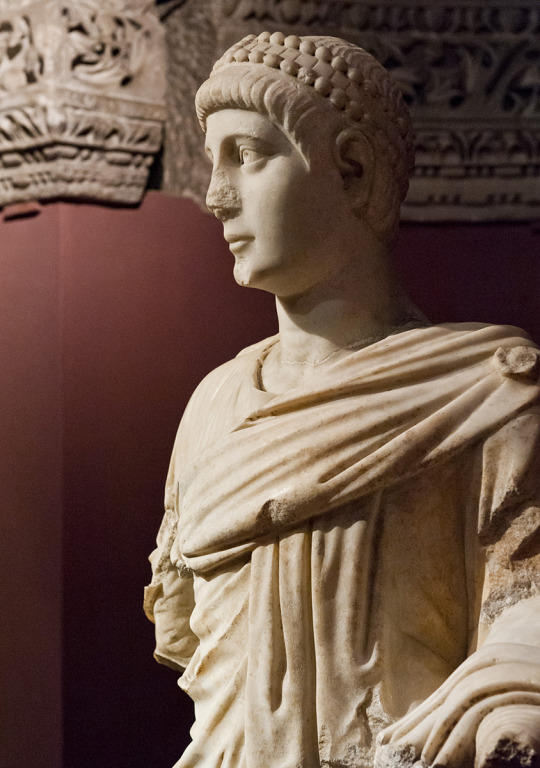

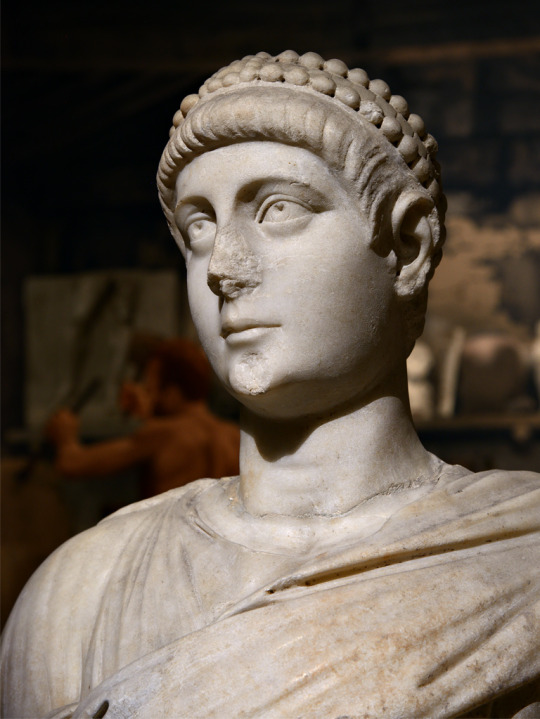
~ Statue of Valentinian II.
Place of origin: Aphrodisias (now Geyre, Aydin).
Date: ca. A.D. 390
Medium: Marble
#ancient#ancient art#history#museum#archeology#ancient sculpture#roman#ancient history#archaeology#ancient roman#statue#Valentinian II#Aphrodisias#Geyre#a.d. 390#4th century#marble
294 notes
·
View notes
Text

Ancient Roman Yellow Glass Jar 3rd-4th century A.D.
#Ancient Roman Yellow Glass Jar#3rd-4th century A.D.#glass#roman glass#ancient artifacts#archeology#archeolgst#history#history news#ancient history#ancient culture#ancient civilizations#ancient rome#roman history#roman empire
71 notes
·
View notes
Text


Ancient Coptic Textiles.
Front cover:
Tapestry Fragment from Egypt 4th century A.D.
For sale in on amazon from my small business:
Red Read Retale.
#red read retale#feed the artist#earth lover#original photographer#textiles#textile art#textile history#ancient coptic textiles#egyptian#egyptian tapestry#4th century A.D.#collectible vintage arts
4 notes
·
View notes
Text

Roman glass flask - 3rd–4th century A.D.
The Getty Museum
360 notes
·
View notes
Text
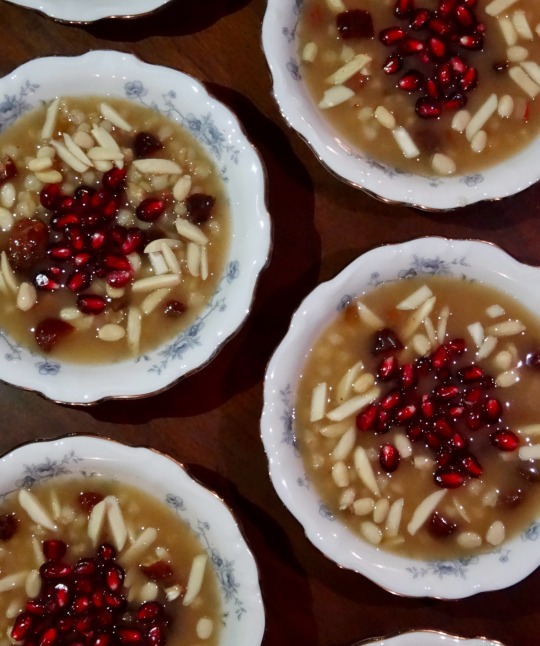

[ID: First image shows four small porcelain bowls of a pudding topped with slivered almonds and pomegranates seeds, seen from above. Second image is an extreme close-up showing the blue floral pattern on the china, slivered almonds, golden raisins, and pomegranate seeds on top of part of the pudding. End ID]
անուշապուր / Anush apur (Armenian wheat dessert)
Anush apur is a sweet boiled wheat pudding, enriched with nuts and dried fruits, that is eaten by Armenians to celebrate special occasions. One legend associates the dish with Noah's Ark: standing on Mt. Ararat (Արարատ լեռը) and seeing the rainbow of God's covenant with humanity, Noah wished to celebrate, and called for a stew to be prepared; because the Ark's stores were diminishing, the stew had to be made with small amounts of many different ingredients.
The consumption of boiled grains is of ancient origin throughout the Levant and elsewhere in West Asia, and so variations of this dish are widespread. The Armenian term is from "անուշ" ("anush") "sweet" + "ապուր" ("apur") "soup," but closely related dishes (or, arguably, versions of the same dish) have many different, overlapping names.
In Arabic, an enriched wheat pudding may be known as "سْنَي��ِيّة" ("snaynīyya"), presumably from "سِنّ" "sinn" "tooth" and related to the tradition of serving it on the occasion of an infant's teething; "قَمْح مَسْلُوق" ("qamḥ masluq"), "boiled wheat"; or "سَلِيقَة" ("salīqa") or "سَلِيقَة القَمْح" ("salīqa al-qamḥ"), "stew" or "wheat stew," from "سَلَقَ" "salaqa" "to boil." Though these dishes are often related to celebrations and happy occasions, in some places they retain an ancient association with death and funerary rites: qamh masluq is often served at funerals in the Christian town of بَيْت جَالَا ("bayt jālā," Beit Jala, near Bethlehem).
A Lebanese iteration, often made with milk rather than water, is known as "قَمْحِيَّة" ("qamḥīyya," from "qamḥ" "wheat" + "ـِيَّة" "iyya," noun suffix).
A similar dish is known as "بُرْبَارَة" ("burbāra") by Palestinian and Jordanian Christians when eaten to celebrate the feast of Saint Barbara, which falls on the 4th of December (compare Greek "βαρβάρα" "varvára"). It may be garnished with sugar-coated chickpeas and small, brightly colored fennel candies in addition to the expected dried fruits and nuts.
In Turkish it is "aşure," from the Arabic "عَاشُوْرَاء" ("'āshūrā"), itself from "عَاشِر" ("'āshir") "tenth"—because it is often served on the tenth day of the month of ٱلْمُحَرَّم ("muḥarram"), to commemorate Gabriel's teaching Adam and Eve how to farm wheat; Noah's disembarkment from the Ark; Moses' parting of the Red Sea; and the killing of the prophet الْحُسَيْن بْنِ عَلِي (Husayn ibn 'Ali), all of which took place on this day in the Islamic calendar. Here it also includes various types of beans and chickpeas. There is also "diş buğdayı," "tooth wheat" (compare "snayniyya").
These dishes, as well as slight variations in add-ins, have varying consistencies. At one extreme, koliva (Greek: "κ��λλυβα"; Serbian: "Кољиво"; Bulgarian: "Кутя"; Romanian: "colivă"; Georgian: "კოლიო") is made from wheat that has been boiled and then strained to remove the boiling water; at the other, Armenian anush apur is usually made thin, and cools to a jelly-like consistency.
Anush apur is eaten to celebrate occasions including New Year's Eve, Easter, and Christmas. In Palestine, Christmas is celebrated by members of the Armenian Apostolic church from the evening of December 24th to the day of December 25th by the old Julian calendar (January 6th–7th, according to the new Gregorian calendar); Armenian Catholics celebrate on December 24th and 25th by the Gregorian calendar. Families will make large batches of anush apur and exchange bowls with their neighbors and friends.
The history of Armenians in Palestine is deeply interwoven with the history of Palestinian Christianity. Armenian Christian pilgrimages to holy sites in Palestine date back to the 4th century A.D., and permanent Armenian monastic communities have existed in Jerusalem since the 6th century. This enduring presence, bolstered by subsequent waves of immigration which have increased and changed the character of the Armenian population in Palestine in the intervening centuries, has produced a rich history of mutual influence between Armenian and Palestinian food cultures.
In the centuries following the establishment of the monasteries, communities of Armenian laypeople arose and grew, centered around Jerusalem's Վանք Հայոց Սրբոց Յակոբեանց ("vank hayots surbots yakobeants"; Monastery of St. James) (Arabic: دَيْر مَار يَعْقُوب "dayr mār ya'qūb"). Some of these laypeople were descended from the earlier pilgrims. By the end of the 11th century, what is now called the Armenian Quarter—an area covering about a sixth of the Old City of Jerusalem, to the southwest—had largely attained its present boundaries.
Throughout the 16th and 17th centuries, the Patriarchate in Jerusalem came to have direct administrative authority over Armenian Christians across Palestine, Lebanon, Egypt, and Cyprus, and was an important figure in Christian leadership and management of holy sites in Jerusalem (alongside the Greek Orthodox and Roman Catholic churches). By the middle of the 19th century, a small population of Armenian Catholics had joined the larger Armenian Apostolic community as permanent residents in Jerusalem, living throughout the Muslim Quarter (but mostly in a concentrated enclave in the southwest); in the beginning of the 20th century, there were between 2,000 and 3,000 Armenians of both churches in Palestine, a plurality of whom (1,200) lived in Jerusalem.
The Turkish genocide of Armenians beginning in 1915 caused significant increases in the populations of Armenian enclaves in Palestine. The Armenian population in Jerusalem grew from 1,500 to 5,000 between the years of 1918 and 1922; over the next 3 years, the total number of Armenians in Palestine (according to Patriarchate data) would grow to 15,000. More than 800 children were taken into Armenian orphanages in Jerusalem; students from the destroyed Չարխափան Սուրբ Աստվածածին վանք (Charkhapan Surb Astvatsatsin Monastery) and theological seminary in Armash, Armenia were brought to the Jerusalem Seminary. The population of Armenian Catholics in the Muslim Quarter also increased during the first half of the 20th century as immigrants from Cilicia and elsewhere arrived.
The immediate importance of feeding and housing the refugees despite a new lack of donations from Armenian pilgrims, who had stopped coming during WW1—as well as the fact that the established Armenian-Palestinians were now outnumbered by recent immigrants who largely did not share their reformist views—disrupted efforts on the part of lay communities and some priests to give Armenian laypeople a say in church governance.
The British Mandate, under which Britain assumed political and military control of Palestine from 1923–1948, would further decrease the Armenian lay community's voice in Jerusalem (removing, for example, their say in elections of new church Patriarchs). The British knew that the indigenous population would be easier to control if they were politically and socially divided into their separate religious groups and subjected to the authority of their various religious hierarchies, rather than having direct political representation in government; they also took advantage of the fact that the ecclesiastical orders of several Palestinian Christian sects (including the Armenian Patriarchate of Jerusalem) comprised people from outside of Palestine, who identified with religious hierarchy and the British authorities more than they identified with the Palestinian lay communities.
British policy, as well as alienating Armenians from politics affecting their communities, isolated them from Arab Palestinians. Though the previously extant Armenian community (called "քաղաքացի" "kaghakatsi," "city-dwellers") were thoroughly integrated with the Arab Palestinians in the 1920s, speaking Arabic and Arabic-accented Armenian and eating Palestinian foods, the newer arrivals (called "زُوَّار" / "զուվվար" "zuwwar," "visitors") were unfamiliar with Palestinian cuisine and customs, and spoke only Armenian and/or Turkish. Thus British policies, which differentiated people based on status as "Arab" (Muslim and Christian) versus "Jewish," left new Armenian immigrants, who did not identify as Arab, disconnected from the issues that concerned most Palestinians. They were predominantly interested in preserving Armenian culture, and more concerned with the politics of the Armenian diaspora than with local ones.
Despite these challenges, the Armenian Patriarchate of Jerusalem came to be a vital center of religious and secular culture for the Armenian diaspora during the British Mandate years. In 1929, Patriarch Yeghishe Turian reëstablished the Սուրբ Յակոբեանց Տպարան ("surbots yakobeants taparan"; St. James printing house); the Patriarchate housed important archives relating to the history of the Armenian people; pilgrimages of Armenians from Syria, Lebanon, and Egypt increased and the economy improved, attracting Armenian immigrants in higher numbers; Armenians held secular roles in governance, policing, and business, and founded social, religious, and educational organizations and institutions; Armenians in the Old and New Cities of Jerusalem were able to send financial aid to Armenian victims of a 1933 earthquake in Beirut, and to Armenians expelled in 1939 when Turkey annexed Alexandretta.
The situation would decline rapidly after the 1947 UN partition resolution gave Zionists tacit permission to expel Palestinians from broad swathes of Palestine. Jerusalem, intended by the plan to be a "corpus separatum" under international administration, was in fact subjected to a months-long war that ended with its being divided into western (Israeli) and eastern (Palestinian) sections. The Armenian population of Palestine began to decline; already, 1947 saw 1,500 Armenians resettled in Soviet Armenia. The Armenian populations in Yafa and Haifa would fall yet more significantly.
Still, the Armenian Patriarchate of Jerusalem maintained its role as the center of Armenian life in Palestine; the compound provided food and shelter to thousands of Armenians during the Battle for Jerusalem and the Nakba (which began in 1948). Some Armenians formed a militia to defend the Armenian Quarter against Haganah shelling during the battle.
In the following years, historical British contributions to the shoring up of insular power in the Patriarchate would cause new problems. The Armenian secular community, no longer empowered to oversee the internal workings of the Patriarchate, could do nothing to prevent embezzling, corruption, and even the sale of church-owned land and buildings to settlers.
In 1967, Israeli military forces annexed East Jerusalem, causing another, albeit smaller, surge in Armenian emigration from the city. Daphne Tsimhoni estimates based on various censuses that the Armenian population of Jerusalem, which had reached 5,000-7,000 at its peak in 1945–6, had fallen back to 1,200 by 1978.
Today, as in the 20th century, Armenians in Jerusalem (who made up nearly 90% of the Armenian population of Palestine as of 1972) are known for the insularity of their community, and for their skill at various crafts. Armenian food culture has been kept alive and well-defined by successive waves of immigrants. As of 2017, the Armenian Patriarchate supplied about 120 people a day with Armenian dishes, including Ղափամա / غاباما "ghapama" (pumpkin stuffed with rice and dried fruits), թոփիկ / توبيك "topig" (chickpea-and-potato dough stuffed with an onion, nut, fruit, and herb filling, often eaten during Lent), and Իչ / ايتش "eetch" (bulgur salad with tomatoes and herbs).
Restaurants lining the streets of the Armenian and Christian quarters serve a mixture of Armenian and Palestinian food. Լահմաջո "lahmadjoun" (meat-topped flatbread), and հարիսա / هريس "harisa" (stew with wheat and lamb) are served alongside ֆալաֆել / فلافل ("falafel") and մուսախան / مسخن ("musakhkhan"). One such restaurant, Taboon Wine Bar, was the site of a settler attack on Armenian diners in January 2023.
Up until 2023, despite fluctuations in population, the Armenian community in Jerusalem had been relatively stable when compared to other Armenian communities and to other quarters of the Old City; the Armenian Quarter had not been subjected to the development projects to which other quarters had been subjected. However, a deal which the Armenian Patriarchate had secretly and unilaterally made with Israel real estate developer Danny Rotham in 2021 to lease land and buildings (including family homes) in the Quarter led Jordan and Palestine to suspend their recognition of the Patriarch in May of 2023.
On 26th October, the Patriarchate announced that it was cancelling the leasing deal. Later the same day, Israeli bulldozers tore up pavement and part of a wall in حديقة البقر ("ḥadīqa al-baqar"; Cows' Garden; Armenian: "Կովերի այգու"), the planned site of a new luxury hotel. On 5th November, Rothman and other representatives of Xana Gardens arrived with 15 settlers—some of them with guns and attack dogs—and told local Armenians to leave. About 200 Armenian Palestinians arrived and forced the settlers to stand down.
On 12th and 13th November, the developer again arrived with bulldozers and attempted to continue demolition. In response, Armenian Palestinians have executed constant sit-ins, faced off against bulldozers, and set up barricades to prevent further destruction. The Israeli occupation police backed settlers on another incursion on 15th November, ordering Armenian residents to vacate the land and arresting three.
On December 28th, a group of Armenian bishops, priests, deacons, and seminary students (including Bishop Koryoun Baghdasaryan, the director of the Patriarchate's real estate department) were attacked by a group of more than 30 people armed with sticks and tear gas. The Patriarchate attributed this attack to Israeli real estate interests trying to intimidate the Patriarchate into abandoning their attempt to reverse the lease through the court system. Meanwhile, anti-Armenian hate crimes (including spitting on priests) had noticeably increased for the year of 2023.
These events in Palestine come immediately after the ethnic cleansing of Լեռնային Ղարաբաղ ("Lernayin Gharabagh"; Nagorno-Karabakh); Israel supplied exploding drones, long-range missiles, and rocket launchers to help Azerbaijan force nearly 120,000 Armenians out of the historically Armenian territory in September of 2023 (Azerbaijan receives about 70% of its weapons from Israel, and supplies about 40% of Israel's oil).
Support Palestinian resistance by donating to Palestine Action’s bail fund; buying an e-sim for distribution in Gaza; or donating to help a family leave Gaza.
Ingredients
180g (1 cup) pearled wheat (قمح مقشور / խոշոր ձաւար), soaked overnight
3 cups water
180-360g (a scant cup - 1 3/4 cup) sugar, or to taste
Honey or agave nectar (optional)
1 cup total diced dried apricots, prunes, golden raisins, dried figs
1 cup total chopped walnuts, almonds, pistachios
1 tsp rosewater (optional)
Ceylon cinnamon (դարչին) or cassia cinnamon (կասիա)
Aniseed (անիսոն) (optional)
Large pinch of salt
Pomegranate seeds, to top (optional)
A Palestinian version of this dish may add pine nuts and ground fennel.
Pearled wheat is whole wheat berry that has gone through a "pearling" process to remove the bran. It can be found sold as "pearled wheat" or "haleem wheat" in a halal grocery store, or a store specializing in South Asian produce.
Amounts of sugar called for in Armenian recipes range from none (honey is stirred into the dish after cooking) to twice the amount of wheat by weight. If you want to add less sugar than is called for here, cook down to a thicker consistency than called for (as the sugar will not be able to thicken the pudding as much).
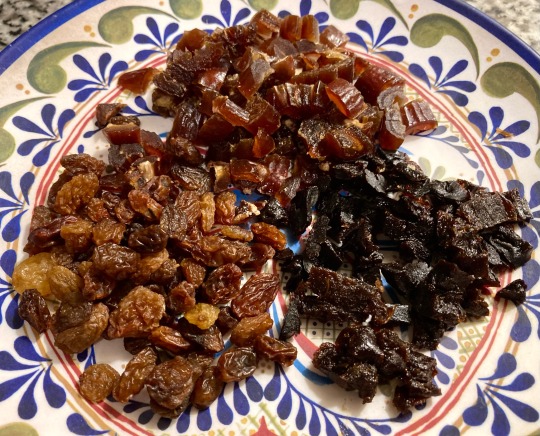
Instructions
1. Submerge wheat in water and scrub between your hands to clean and remove excess starch. Drain and cover by a couple inches with hot water. Cover and leave overnight.
2. Drain wheat and add to a large pot. Add water to cover and simmer for about 30 minutes until softened, stirring and adding more hot water as necessary.

Wheat before cooking

Wheat after cooking
3. Add dried fruit, sugar, salt, and spices and simmer for another 30 minutes, stirring occasionally, until wheat is very tender. Add water as necessary; the pudding should be relatively thin, but still able to coat the back of a spoon.
4. Remove from heat and stir in rosewater and honey. Ladle pudding into individual serving bowls and let cool in the refrigerator. Serve cold decorated with nuts and pomegranate seeds.
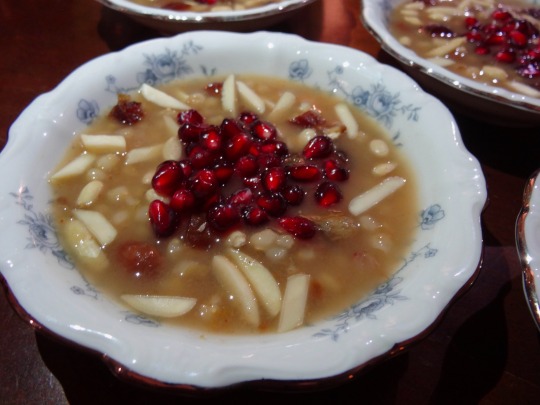
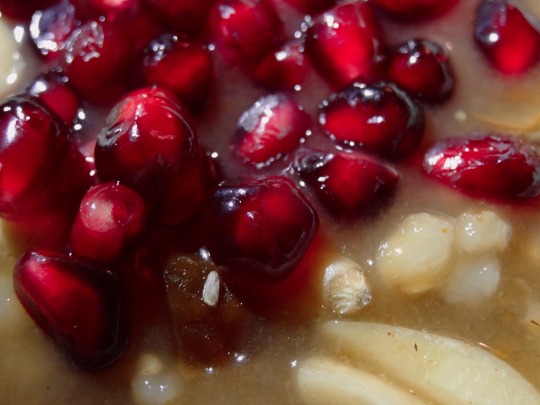
#the last link is a different / new fundraiser#Armenian#Palestinian#fusion#wheat berries#pearled wheats#pomegranate#prunes#dried apricot#dates#long post /
376 notes
·
View notes
Text
Phos Hilaron one of the oldest Christian hymns surviving (circa 3rd-4th century A.D.) my beloved
166 notes
·
View notes
Text


16/11/24
Marble statue of Hermes
Roman, Imperial period, 1st or 2nd century A.D. Copy or adaptation of a Greek statue of the late 5th or early 4th century B.C.
The statue is almost intact, although the surface was strongly cleaned as was the custom in the eighteenth century. During that period, newly excavated ancient sculpture was cleaned and restored in Roman workshops before being sold to members of the European nobility. This work was acquired by the English statesman William Fitzmaurice, second earl of Shelburne, who assembled a distinguished collection of antiquities at Lansdowne House in London. The statue of Hermes once stood in a niche in the dining room at Lansdowne House, serving the same decorative function that it doubtless once served in a Roman villa of the first or second century A.D. The dining room, designed by Robert Adam, is now at the Metropolitan Museum, where it is installed with other period rooms from England.
#photographers on tumblr#original photography#dark academia#dark academia aesthetic#classic academia#classic academia aesthetic#chaotic academia#chaotic academia aesthetic#art#greek mythology#cottagecore#cottagecore aesthetic#cottage aesthetic#dark cottagecore#nature photography#nature#naturecore#nature aesthetic#gardencore#earthcore#fairycore#fairy aesthetic#softcore#soft aesthetic#autumn#autumncore#autumn aesthetic
31 notes
·
View notes
Text
Legendary creatures: Kitsune, Kumiho, hồ ly tinh, and huli jing
Fox spirits such as kitsune (狐, きつね) of Japan, kumiho (Hangul 구미호 or Hanja 九尾狐) of Korea, hồ ly tinh (狐狸精) of Vietnam, or huli jing (狐狸精) of China are shape-shifting fox spirits, usually having nine tails. They are typically tricksters that can be either benevolent or malevolent.

By Unknown painter from late 4th to mid 5th century A.D., unknown photographer - http://www.sohu.com/a/193975015_556515, Public Domain, https://commons.wikimedia.org/w/index.php?curid=73024755
The oldest version of the nine-tailed fox spirits was from China. The first story that has the juli jing was the Shanhaijin (山海经 Classic of Mountains and Seas) which was compiled sometime in the fourth century BCE, but the currently known form wasn't completed until the early Han dynasty (202 BCE - 9 CE). It contained stories fables of the pre-Qin dynasty (prior to about 700 BCE). It says '靑丘國在其北其人食五穀衣絲帛其狐四足九尾。 The Land of Blue Hills lies to the north where the inhabitants consume the Five Grains, wear silk and worship foxes that have four legs and nine tails.' The nine-tailed fox was seen as a good omen, only appearing in times of peace. However, it also says 'Three hundred li [150km/93.2 miles]farther east is Qingqiu Mountain, where much jade can be found on its south slope and green cinnabar on its north. There is a beast here whose form resembles a fox with nine tails. It makes a sound like a baby and is a man-eater. Whoever eats it will be protected against insect-poison (gu).' During the Han dynasty, the mythology added the ability to shape-shift into humans as they became older, one description of which was by Guo Pu (郭璞, 276-326 CE) 'When a fox is fifty years old, it can transform itself into a woman; when a hundred years old, it becomes a beautiful female, or a spirit medium, or an adult male who has sexual intercourse with women. Such beings are able to know things at more than a thousand miles' distance; they can poison men by sorcery, or possess and bewilder them, so that they lose their memory and knowledge; and when a fox is thousand years old, it ascends to heaven and becomes a celestial fox.'
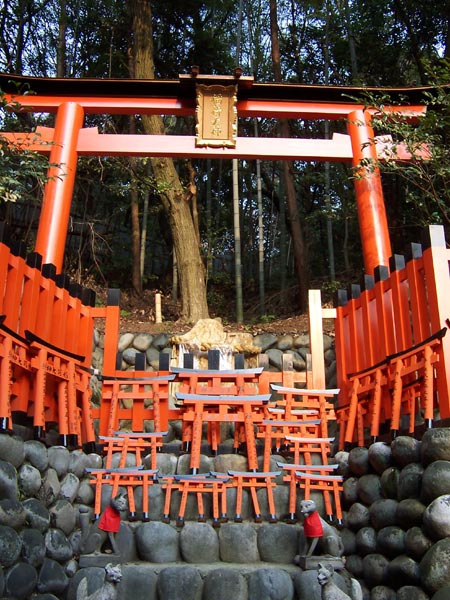
By Chris Gladis (MShades) from Kyoto, Japan - Flickr, CC BY 2.0, https://commons.wikimedia.org/w/index.php?curid=748434
Fox worship arrived in Japan sometime during the Jomon period (14,000-300 BCE) as evidenced by necklaces including canine teeth and jawbones of foxes. Stories from China were brought to Japan by merchants who traded and brought in as kyuubi no kitsune (九尾の狐, nine-tailed fox). In the Nihon Shoki (日本書紀, the Chronicles of Japan), which is the second-oldest book of Japanese history, mentions foxes twice, both times as omens. It records that in 657 a byakko (white fox) in Iwami Province was a good omen. In 659, a fox bit a vine a construction worker and it was seen as an ill omen. There were tales of kitsune turning into kitsune nyoubo (狐女房 fox wife) that are revealed as foxes after pet dogs that were recorded in the Nihon Ryouki (日本霊異記) book of fables during the Heian period (recorded between 787-824).

By Hùng Phong Lê - Hùng Phong Lê, Public Domain, https://commons.wikimedia.org/w/index.php?curid=134883158
The Hồ ly tinh have specific ages that they have to reach to gain their tails. They must practice for a hundred years to have three tails and be considered a 'demon fox', for a thousand years to become a 'ghost fox' with six tails. When it gains nine tails, it's considered a 'celestial fox' and can turn its tails into humans. If the fox loses its tail, it dies. In the Đại Việt sử ký toàn thư (chữ Hán: 大越史記全書, Complete annals of Đại Việt), compiled in 1697, states that Emperor Lê Thái Tổ was saved by a hồ ly tinh when he was hiding in Lam Sơn from the Ming army. He took the time during his hiding to bury a girl in a white dress and that a white fox distracted the army when he was almost caught.
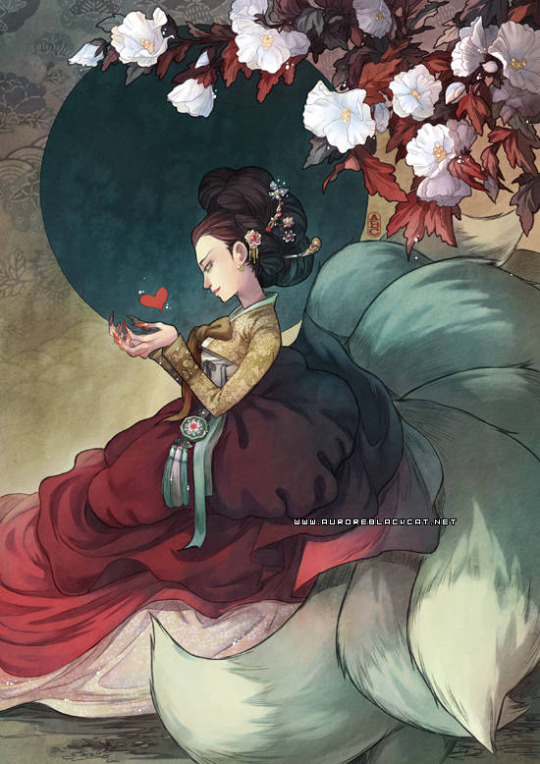
source: https://www.deviantart.com/auroreblackcat/art/Gumiho-283762936
The kumiho are able to become beautiful women who seduce men to eat their liver or heart. The Chinese story entered into Korea during the Three Kingdoms period (삼국시대, from about 494-562) and state that foxes become kumiho with great age and become stronger with that age, too. The kumiho were largely viewed neutrally, though self-centered in their need for human organs and souls. It wasn't until later that they were viewed as evil, bloodthirsty fox-human hybrids that might turn into humans if they can avoid eating human flesh for a thousand years. Something unique to the kumiho is that they develop and pass along 'yeowoo geseul' (여우구슬, 'fox marbles' that they give to and then take back from humans by an action that looks like kissing. It can only remain in the human part of the chain for a year before it can kill them completely. When it's returned to the fox part of the chain, the human has no memory of the yeowoo guseul or the kumino.
#kitsune#kumiho#huli jing#hồ ly tinh#nine tailed fox#spirit foxes#japanese folklore#chinese folklore#vietnamese folklore#korean folklore#legendary creature
25 notes
·
View notes
Text


On August 3rd 1305 William Wallace was betrayed and handed over to the English.
One of the biggest misconceptions in the story about Wallace is that Robert the Bruce betrayed him, this is not true and one of many inaccuracies in the Hollywood film Braveheart, a great film in it’s own right, but it was not a true depiction on our heroes life, it was a Hollywood love story.
There has been debate about Wallace’s betrayal for centuries while Blind Harry’s accounts might be called into question because it was written over 250 years after the events, Sir John Menteith is the man that history has judged to have betrayed Wallace, Menteith’s descendants have argued that but for Harry’s account and tradition, there is no proof that the then sheriff of Dumbarton is innocent, they also say as the Sheriff of Dumbarton he may only have been doing his lawful duty, but as he was appointed by Edward king of England in my opinion this duty was illegal anyway
However putting the ancestors protests aside you only have to take a look at the evidence in the ‘Chronicle of Lancaster,’ written in the thirteenth century, where it is stated that 'William Wallace was taken by a Scotsman, namely, Sir John Menteith, and carried to London, where he was drawn, hanged, and beheaded. also in the account of the capture and execution of Wallace contained in the Arundel manuscript, written about the year 1320, it is stated that 'William Wallace was seized in the house of Ralph Rae by Sir John Menteith, and carried to London by Sir John de Segrave, where he was judged. John of Fordun a Scottish Chronicler wrote less than 100 years afterwards that..
'The noble William Wallace was, by Sir John Menteith, at Glasgow, while suspecting no evil, fraudulently betrayed and seized, delivered to the King of England, dismembered at London, and his quarters hung up in the towns of the most public places in England and Scotland, in opprobium of the Scots.’
Whatever the actual events there is little doubt in my mind of Menteith’s involvement, Wallace was held in Dumbarton Castle but by the 23rd of August, which to me seems a remarkably short amount of time, they had taken Wallace to London had a show trial and executed him, more to come of that in a few weeks time.
Pics are of The Wallace monument at Robroyston, the monument is a 20 foot high granite Celtic cross paid for by public subscription and unveiled before a crowd of around 1000 people at 4:30pm on Saturday 4th August 1900. The keen eyed among you will have noticed that the plaque says he was captured on August 5th, but my source in The Society of William Wallace has p[previously assured me that it was on the 3rd, those details read;
This memorial erected 1900 A.D. By public subscription is to mark the site of the house in which the hero of Scotland was basely betrayed and captured about midnight on 5th August 1305 when alone with his faithful friend and co patriot Kerlie Who was slain.
Wallace’s heroic patriotism as conspicuous in his death as in his life so roused and inspired his country that within nine years of his betrayal the work of his life was crowned with victory and Scotland’s independence regained on the Field of Bannockburn.
On the cross in stone is
In Defence
Then the Lion Rampant followed by
WALLACE MCCCV
&
"Dico Tibi Verum Libertas Optima Rerum Nunquam Servili Sub Nexu Vivito Fili"
Taught to Wallace in his boyhood.
(Latin translation as: "My Son, Freedom is best, I tell thee true, of all things to be won. Then never live within the Bond of Slavery.") "We are not here to sue for peace but to fight for the freedom of our country" Wallace at Stirling Bridge
Who dared to nobly stem tyrannic pride or nobly die
Burns.
I think the fact that so many attended that day, and the fact the public paid for the Cross speaks volumes, many see the story of Sir William Wallace as a modern reincarnation due to the film Braveheart, while this may have ignited the interest of many a Scot scattered around the globe with the Diaspora, it shows that Wallace was and is still a large part of the Scottish psyche.
44 notes
·
View notes
Note
hey so what do you think of the fact that Hades was seen as an anti Zeus and an equal to Zeus
Ovid, Fasti 4. 443 (trans.Boyle) (Roman poetry C1st B.C. to C1st A.D.) "[Zeus speaks :] ‘My rank is no greater [than Haides]. I hold court in the sky; another rules the sea [Poseidon], and one the void [Haides].’"
Seneca, Hercules Furens 53 (trans. Miller) (Roman tragedy C1st A.D.) "Dis [Haides] himself, who drew a lot equal to Jove's [Zeus's]."
I usually like to use the older sources as well in order compare them. Even in the Iliad and Homeric Hymns to Demeter Hades seems to be treated on equal foot with Zeus, so this is a general idea ancient people had on him, rather than a "1st Century Idea" or "Something completely baseless stupid Ovid randomly came up with." (Though I think it should be also be pointed out the fact that Ancient Greeks feared Hades more, and he started to be actually worshipped by the romans, to put it roughly.)
Homer, Iliad 15. 187 ff (trans. Lattimore) (Greek epic C8th B.C.) : "We are three brothers born by Rheia to Kronos (Cronus), Zeus, and I [Poseidon], and the third is Aides [Haides] lord of the dead men. All was divided among us three ways, each given his domain. I [Poseidon] when the lots were shaken drew the grey sea to live in forever; Aides drew the lot of the mists and the darkness, and Zeus was allotted the wide sky, in the cloud and the bright air. But earth and high Olympos are common to all three."
Homeric Hymn 2 to Demeter (trans. Evelyn-White) (Greek epic C7th - 4th B.C.) : "Aidoneus Polysemantor (Ruler of Many), is . . . your [Demeter's] own brother and born of the same stock : also, for honour, he has that third share which he received when division was made at the first, and is appointed lord of those among whom he dwells."
To me it basically shows how different ancient people's perception was on him, compared to the modern views. I've usually seen people picking two extremes based on the fact that he's the King of the Underworld, where he's portrayed either as:
a) A satanic figure because they apply a Christian mentality on a Hellenistic Polytheistic religion and associate Mount Olympus with Heaven and the Underworld with Hell (and by extension Hades is treated like some sort of a Luciferian type of being; basically Paradise Rot meets Greek Mythology),
...or...
b) A misunderstood guy who unfairly got the Underworld during the division of the Cosmos and deserved better than the corpse cellar. Based on this interpretation/misconception people usually start making lots of headcanons that are further spred as facts, such a "Hades was the one who deserved to be King of the Gods but Zeus tricked him." or "Hades was hated even by his own family just because he was the god of the dead."
The problem in both of these cases is that the Underworld is perceived from a negative perspective, as something inferior, deplorable, therefore leading to this very popular (and shallow) idea that Zeus got the best and Hades the worst. When in reality, the Underworld itself comes with some great peaks as well. Besides the fact that you're disproportionately rich, every person who died eventually becomes your subject. Since Zeus rules the "Aboveworld", I personally like to perceive it as a beautiful metaphor: you start in the realm of Zeus and end up in the realm of Hades (hence the Anti-Zeus).
Ancient people feared him and avoided writing or saying his name because of the nature of his kingdom; because - quess what - people usually don't like dying (and considering the fact that back then lots of them were passing away at very young ages due to disturbing causes I can tell why).
13 notes
·
View notes
Text

Atticus of Aphrodisia (Roman Art)
Muse of Atticus of Aphrodisia, last thirty years of the 4th century AD, grained cario marble, 187 cm
Gallerie degli Uffizi, Florence Inv. 1914 n.269
Thanks to the Latin inscription engraved on the base, we know the name of the author, an otherwise unknown Atticus of Aphrodisia. The artist was originally from a city in Caria, a region of Asia Minor, which, since the 1st century A.D., had been famous for its workshops of marble workers who exploited the nearby white marble quarries. The Aphrodian artists also set up workshops in Rome, often being employed in various parts of the Empire in construction sites commissioned by the emperor, such as the Severian Forum of Leptis Magna in Libya. (Uffizi)
8 notes
·
View notes
Text

A ROMAN GREEN GLASS JAR CIRCA 4TH-5TH CENTURY A.D.
#A ROMAN GREEN GLASS JAR#CIRCA 4TH-5TH CENTURY A.D.#glass#roman glass#ancient glass#ancient artifacts#archeology#archeolgst#history#history news#ancient history#ancient culture#ancient civilizations#ancient rome#roman history#roman empire
63 notes
·
View notes
Text

1st-4th century A.D. carved marble statue of the Buddha with rays emanating from it, suggesting syncretism with Apollo or Mithras. Found at Berenike, a Ptolemaic-Roman port on the Red Sea coast of Egypt.
245 notes
·
View notes
Text

Cleopatra the Alchemist (Greek: Κλεοπάτρα; fl. c. 3rd century AD) was a Greek alchemist, writer, and philosopher. She experimented with practical alchemy but is also credited as one of the four female alchemists who could produce the philosopher's stone. Some writers consider her to be the inventor of the alembic, a distillation apparatus. She appears to have been active in Alexandria in the 3rd century or 4th century A.D. She is associated with the school of alchemy typified by Mary the Jewess and Comarius. These alchemists used complex apparatus for distillation and sublimation.
Art by Sato Futaba author of the historical mangas "Utae, Erinna!" and "Anna Komnene"
#ancient rome#roman egypt#alchemy#ancient alchemist#women alchemist#women scientists#women's history#women in history#women at work#Cleopatra#Cleopatra the alchemist#historical person#historical art#manga#Sato Futaba
9 notes
·
View notes
Text
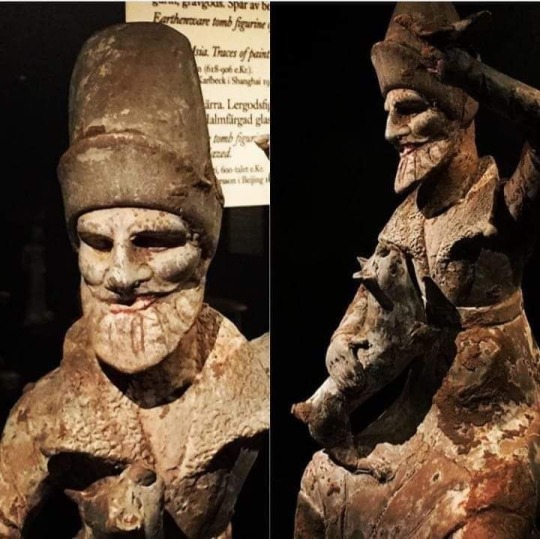
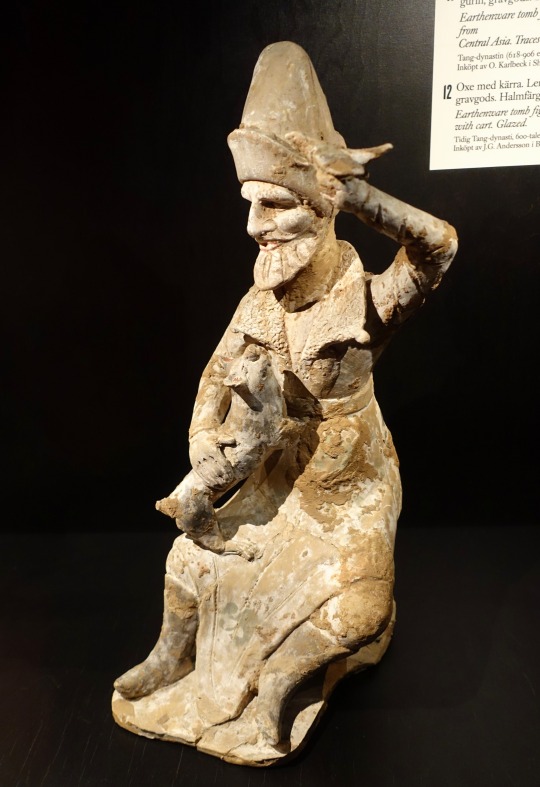
Tomb figurine of a man (Sogdian) from Central Asia and his pet. From China, Tang dynasty, 618-906 CE, earthenware with traces of paint - Östasiatiska museum, Stockholm, Sweden.
"This writer (Kim Jin-heon) has been interested in the life of ancient Sogdians for many years. They accumulated many riches through trade with Rome and Tang, and they built marvelous buildings in Samarkand, Uzbekistan that still exist today. They were especially prosperous from the 4th to the 8th century A.D.
Most Sogdians lived near Samarkand, a small-sized city, as descendants of Iranians. The area was a transportation hub as well as a strategic foothold, linking the East and West, between India and the Steppes region.
These geopolitical traits enticed powerful surrounding countries to conquer the region and have hegemony over it. This kind of history caused the tribe to always be subject to colonization. As a way to survive the situation, Sogdians learned various languages and acquired the traits of many cultures. They were known as outgoing and ambitious.
With the desert and the Silk Road as their main "natural" resources, Sogdians were raised at a young age to be merchants. For example, when boys became five, they began to learn foreign languages with the aim to engage in business."
-Kim Jin-heon, The Korea Times
#sogdiana#iranian#art#history#dog art#ancient history#statue#museums#ancient art#tang dynasty#indo european
55 notes
·
View notes
Text
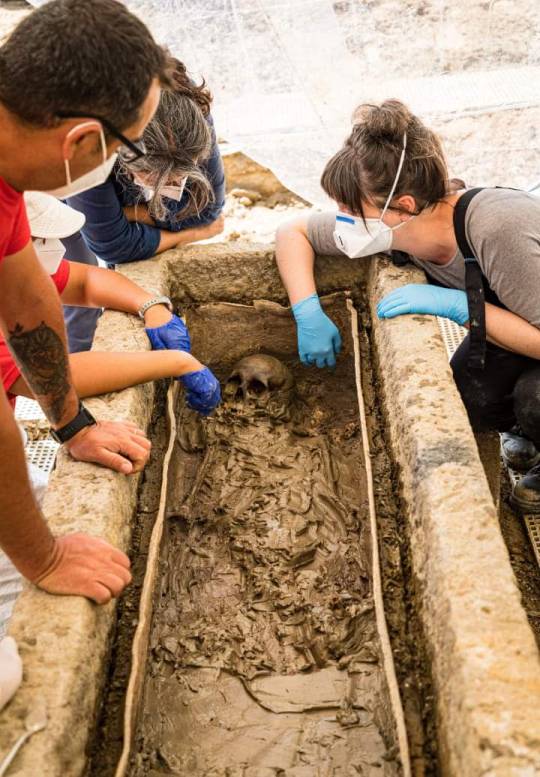
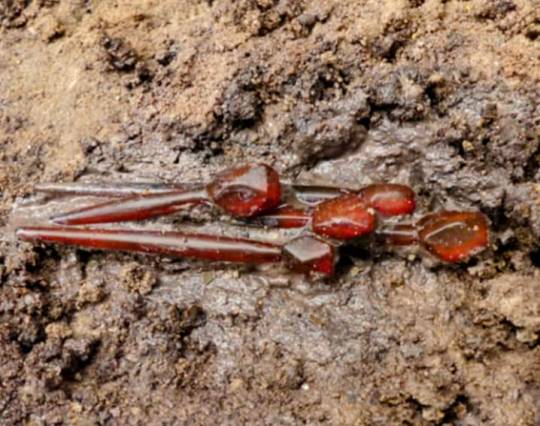
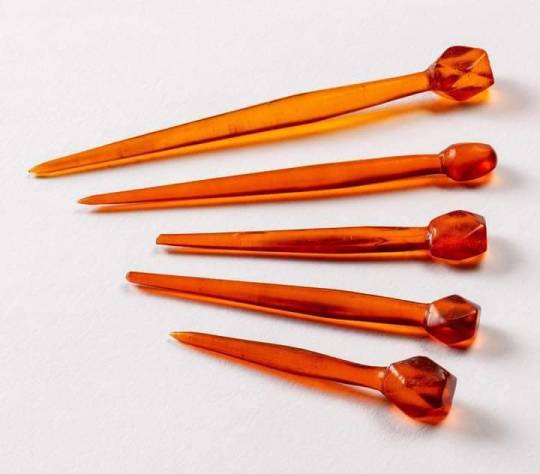
Baltic amber was worn by people of great status and wealth.
Autun, France was founded as Augustodunum by the Emperor Augustus as the capital of the Aedui people in the 1st century A.D. Most recent excavations have revealed the wealth and prestige of an ancient center of learning.
A set of 4th century carved Baltic amber pins were found in one of the burial sites. The pins are of such high quality and in such impeccable conditions that there are no comparable groups in the archaeological record.
The Amber Road trade route went from the Baltic Coast to the Mediterranean, then from the Black Sea to Egypt, and then was carried to Asia through the Silk Road.
16 notes
·
View notes